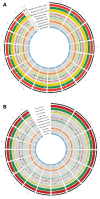Prediction of pathogenicity genes involved in adaptation to a lupin host in the fungal pathogens Botrytis cinerea and Sclerotinia sclerotiorum via comparative genomics
- PMID: 31101009
- PMCID: PMC6525431
- DOI: 10.1186/s12864-019-5774-2
Prediction of pathogenicity genes involved in adaptation to a lupin host in the fungal pathogens Botrytis cinerea and Sclerotinia sclerotiorum via comparative genomics
Abstract
Background: Narrow-leafed lupin is an emerging crop of significance in agriculture, livestock feed and human health food. However, its susceptibility to various diseases is a major obstacle towards increased adoption. Sclerotinia sclerotiorum and Botrytis cinerea - both necrotrophs with broad host-ranges - are reported among the top 10 lupin pathogens. Whole-genome sequencing and comparative genomics are useful tools to discover genes responsible for interactions between pathogens and their hosts.
Results: Genomes were assembled for one isolate of B. cinerea and two isolates of S. sclerotiorum, which were isolated from either narrow-leafed or pearl lupin species. Comparative genomics analysis between lupin-derived isolates and others isolated from alternate hosts was used to predict between 94 to 98 effector gene candidates from among their respective non-conserved gene contents.
Conclusions: Detection of minor differences between relatively recently-diverged isolates, originating from distinct regions and with hosts, may highlight novel or recent gene mutations and losses resulting from host adaptation in broad host-range fungal pathogens.
Keywords: Botrytis cinerea; Comparative genomics; Lupin; Sclerotinia sclerotiorum.
Conflict of interest statement
The authors declare that they have no competing interests.
Figures

Similar articles
-
Genomic analysis of the necrotrophic fungal pathogens Sclerotinia sclerotiorum and Botrytis cinerea.PLoS Genet. 2011 Aug;7(8):e1002230. doi: 10.1371/journal.pgen.1002230. Epub 2011 Aug 18. PLoS Genet. 2011. PMID: 21876677 Free PMC article.
-
An Interspecies Comparative Analysis of the Predicted Secretomes of the Necrotrophic Plant Pathogens Sclerotinia sclerotiorum and Botrytis cinerea.PLoS One. 2015 Jun 24;10(6):e0130534. doi: 10.1371/journal.pone.0130534. eCollection 2015. PLoS One. 2015. PMID: 26107498 Free PMC article.
-
A multiplex PCR assay for the detection and quantification of Sclerotinia sclerotiorum and Botrytis cinerea.Lett Appl Microbiol. 2016 May;62(5):379-85. doi: 10.1111/lam.12566. Lett Appl Microbiol. 2016. PMID: 26997098
-
Recent Advances in the Study of the Plant Pathogenic Fungus Botrytis cinerea and its Interaction with the Environment.Curr Protein Pept Sci. 2017;18(10):976-989. doi: 10.2174/1389203717666160809160915. Curr Protein Pept Sci. 2017. PMID: 27526927 Review.
-
Botrytis cinerea virulence factors: new insights into a necrotrophic and polyphageous pathogen.FEMS Microbiol Lett. 2007 Dec;277(1):1-10. doi: 10.1111/j.1574-6968.2007.00930.x. FEMS Microbiol Lett. 2007. PMID: 17986079 Review.
Cited by
-
Phylogenomics and adaptive evolution of the Colletotrichum gloeosporioides species complex.Commun Biol. 2025 Apr 10;8(1):593. doi: 10.1038/s42003-025-08024-9. Commun Biol. 2025. PMID: 40204844 Free PMC article.
-
Infection Strategies and Pathogenicity of Biotrophic Plant Fungal Pathogens.Front Microbiol. 2022 Jun 2;13:799396. doi: 10.3389/fmicb.2022.799396. eCollection 2022. Front Microbiol. 2022. PMID: 35722337 Free PMC article. Review.
-
An automated and combinative method for the predictive ranking of candidate effector proteins of fungal plant pathogens.Sci Rep. 2021 Oct 5;11(1):19731. doi: 10.1038/s41598-021-99363-0. Sci Rep. 2021. PMID: 34611252 Free PMC article.
-
Deciphering the Infectious Process of Colletotrichum lupini in Lupin through Transcriptomic and Proteomic Analysis.Microorganisms. 2020 Oct 21;8(10):1621. doi: 10.3390/microorganisms8101621. Microorganisms. 2020. PMID: 33096724 Free PMC article.
-
BcMettl4-Mediated DNA Adenine N6-Methylation Is Critical for Virulence of Botrytis cinerea.Front Microbiol. 2022 Jun 30;13:925868. doi: 10.3389/fmicb.2022.925868. eCollection 2022. Front Microbiol. 2022. PMID: 35847085 Free PMC article.
References
-
- Gladstones J. Distribution, origin, taxonomy, history and importance. In: ‘Lupins as crop plants—biology, production and utilization’.(Eds JS Gladstones, C Atkins, J Hamblin) pp. 1–40. In. Cambridge: Cambridge University Press. p. 1998.
-
- Caballero B, Finglas P, Toldrá F. Encyclopedia of food and health, 1st edn: academic. 2015.
-
- Clements JC, Wilson J, Sweetingham MW, Quealy J, Francis G. Male sterility in three crop Lupinus species. Plant Breed. 2012;131(1):155–163.
-
- Western Australian lupin industry [https://www.agric.wa.gov.au/grains-research-development/western-australi...].
-
- White P, French B, McLarty A: Producing lupins. In. Edited by Department of Agriculture and Food, 2nd edn. Perth: South Perth, W.a. : Department of Agriculture and Food; 2008.
MeSH terms
Substances
Grants and funding
LinkOut - more resources
Full Text Sources

